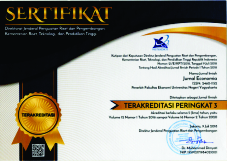The Effect of Internet Technology on Women's Decision to Work at Home
Downloads
Abstract: This study aims to analyze the effect of internet technology and social demographic variables on women's decisions to work at home. Using National Labor Force Survey (Sakernas) conducted in February 2018, this study observed working women aged 15 years and over, which amounts to 36.378 observations. The model in this research is using logistic regression. The result shows that women who use the internet for primary jobs are more likely to work at home than those who do not use the internet. This study argued that internet supports flexible work for women. In general, internet technology is used for communication with consumers and promotional needs. Further analysis suggests that a policy is needed to improve communication infrastructure in rural areas as well as internet use to develop brand and transaction effectiveness. The younger woman, highly educated, experienced in training and living in rural areas are more likely to prefer working at home.
Keywords: Internet Technology, Work at Home, Women Work.
Pengaruh Teknologi Internet Terhadap Keputusan Perempuan untuk Bekerja di Rumah
Abstrak: Penelitian ini bertujuan untuk melihat peranan variabel teknologi internet dan variabel karakteristik sosial demografi terhadap keputusan perempuan untuk memilih bekerja di rumah. Data yang digunakan bersumber dari Survei Angkatan Kerja Nasional (Sakernas) Februari 2018, unit analisisnya adalah perempuan berumur 15 tahun ke atas yang berstatus bekerja dengan observasi berjumlah 36.378. Metode yang digunakan adalah analisis regresi logistik. Hasil penelitian menunjukkan bahwa perempuan yang memanfaatkan teknologi internet pada pekerjaan utama lebih berpeluang untuk bekerja di rumah dibandingkan dengan perempuan yang tidak menggunakan internet. Penelitian ini menyatakan bahwa internet mendukung terciptanya pekerjaan yang sifatnya fleksibel untuk perempuan. Secara umum teknologi internet digunakan untuk komunikasi dengan konsumen dan promosi. Peluang perempuan umur 15 tahun ke atas akan semakin besar untuk bekerja di rumah jika: berumur 15-24 tahun dan berumur 25-39 tahun; berstatus tidak kawin; berpendidikan tinggi (SMA ke atas); pernah mengikuti pelatihan kerja; dan tinggal di perdesaan.
Kata kunci: Teknologi Internet, Bekerja di Rumah, Perempuan Bekerja.
Downloads
Anggraeni, N. D. (2015). Determinan Alokasi Waktu Bekerja Perempuan Menikah di Indonesia. Tesis. Tidak diterbitkan. Depok: Program Pascasarjana Kajian Kependudukan dan Ketenagakerjaan Universitas Indonesia.
Anker, R. (1998). Gender and Jobs : Sex Segregation of Occupations in the World. Geneva: International Labor Organization.
Artha, R. P. (2003). Determinan Partisipasi Angkatan Kerja Perempuan Kawin di Indonesia : Analisis Data Survey Sosial Ekonomi Nasional (SUSENAS) 1998. Skripsi. Tidak Diterbitkan. Depok: Fakultas Ekonomi Universitas Indonesia.
Atasoy, Hilal. (2013). The effects of broadband Internet expansion on labor market outcomes. ILR Review, 66(2): 315–45.
Asiati, D. (2004). Penawaran Tenaga Kerja Kawin di Indonesia (Analisis Data Susenas 2002). Tesis. Tidak diterbitkan. Depok: Program Pasca Sarjana Kajian Kependudukan dan Sumber Daya Manusia Universitas Indonesia.
Becker, G. S. (1965). A Theory of the Allocation of Time. The Economic Journal, Vol 75 No 299, 75 (299), 493-517.
Berke, D. L. (2003). Coming Home Again The Challenges and Rewards of Home-Based Self-Employment. Journal of Family Issues, 24 (4), 513-546.
Borjas, G. J. (2013). Labor Economics 6th Edition. New York: Mcgraw-Hill Irwin.
Benyamin, D. (1996). Women and the Labour Market in Indonesia during the 1980s', in Susan Horton (ed.), Women and Industrialization in Asia, Routledge, New York.
Christensen, K. E. (1987). Impacts of Computer-Mediated Home-Based Work on Women and Their Families. Office Technology and People Vol 3 Iss 3 , 3 (3), 211-230.
Dettling, L. J. (2017). Broadband in the labor market: the impact of residential high-speed internet on married women's labor force participation. ILR Review, 70(2), 451-482.
Dewi, P. M. (2012). Partisipasi tenaga kerja perempuan dalam meningkatkan pendapatan keluarga. Jurnal Ekonomi Kuantitatif Terapan, 5(2).
Edwards, L. N., & Hendrey, E. F. (2002). Home-Based Work and Women's Labor Force Decisions. Journal of Labor Economics Vol 20, 20 (1), 170-200.
Eurofound/ILO, (2017), Working Anytime, Anywhere: The Effects on the World of Work, Publications Office of the European Union, Luxembourg, and the International Labour Office, Geneva.
Maryati, S., Elfindri, E., & Bachtiar, N. (2018). Analysis Supply of Women Labor Who Have Toddler At Rural Area In West Sumatra. Jurnal Ekonomi dan Pembangunan Indonesia (JEPI), 26(1).
Widarti, D. (1998). Determinants of labour force participation by married women: the case of Jakarta. Bulletin of Indonesian Economic Studies, 34(2), 93-120.
Tingum, E. N. (2016). Estimating The Likelihood of Women Working in The Service Sector in Formal Enterprises: Evidence From Sub-Saharan African Countries. Journal of Economics and Sustainable Development, 7(2).
OECD, (2017) Going digital: The future of work for women. The Pursuit of Gender Equality: An Uphill Battle, Paris: OECD, pp.269282. http://dx.doi.org/10.1787/9789264281318-26-en, accessed 26.11.2017.
OECD, (2016), "Skills for a Digital World: 2016 Ministerial Meeting on the Digital Economy Background Report", OECD Digital Economy Papers, No. 250, OECD Publishing, Paris, http://dx.doi.org/10.1787/5jlwz83z3wnw-en.
Gronau, R. (1977). Leisure, Home Production, and Work the Theory of the Allocation of Time Revisited. Journal of Political Economy , 85 (6), 1099-1123.
Gujarati, D. (2011). Econometrics by Example. London: Palgrave Macmillan.
Halford S (2005) Hybrid workspace: Re-specialisations of work, organisation and management. New Technology, Work and Employment 20(1): 19–37.
Mason C, Carter S and Tagg S (2008) Invisible Businesses: The Characteristics of Home-Based Businesses in the United Kingdom.WP-o8-01. Glasgow: Strathclyde University.
Mincer, J. (1962). Labor Force Participation of Married Women: A Study of Labor Supply. Princeton: Princeton University Press.
Oettinger, G. S. (2010). The Incidence and Wage Consequences of Home-Based Work in the United States, 1980–2000. The Journal of Human Resources, 46 (2), 238-260.
Still LV and Walker EA (2006) The self-employed woman owner and her business : An Australian proï¬le.Women in Management Review 21(4): 294–310.
Wellington, A. J. (2006). Self-employment: the new solution for balancing family and career? Labour Economics , 13, 357-386.
Wynarczyk, P., & Graham, J. (2013). The impact of connectivity technology on home-based business venturing: The case of women in the North East of England. Local Economy, 28(5), 451-470.















